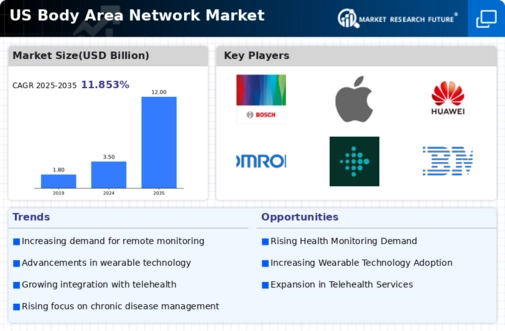Increased Focus on Preventive Healthcare
The body area-network market is significantly impacted by the increasing focus on preventive healthcare. As healthcare systems shift from reactive to proactive approaches, there is a growing demand for technologies that support early detection and intervention. This trend is particularly relevant in the US, where healthcare costs continue to rise. The body area-network market is likely to see a surge in products designed to facilitate preventive measures, such as wearable devices that track health metrics and provide actionable insights. Market analysts suggest that the preventive healthcare segment could account for over 30% of the total healthcare expenditure in the coming years, underscoring the importance of this driver.
Rising Demand for Remote Patient Monitoring
The body area-network market experiences a notable surge in demand for remote patient monitoring solutions. This trend is driven by an increasing emphasis on chronic disease management and the need for continuous health monitoring. In the US, the prevalence of chronic conditions such as diabetes and hypertension is projected to rise, necessitating innovative solutions. The body area-network market is poised to benefit from this demand, as healthcare providers seek to leverage technology to enhance patient outcomes. According to recent estimates, the remote patient monitoring segment is expected to grow at a CAGR of approximately 25% over the next five years, indicating a robust market potential.
Growing Integration of Artificial Intelligence
The integration of artificial intelligence (AI) into the body area-network market is emerging as a transformative driver. AI technologies enhance data analysis capabilities, enabling more accurate health assessments and personalized care. In the US, healthcare providers are increasingly adopting AI-driven solutions to improve patient outcomes and streamline operations. The body area-network market stands to benefit from this trend, as AI can facilitate predictive analytics and real-time decision-making. By 2026, the AI healthcare market is projected to reach $36 billion, indicating a substantial opportunity for growth within the body area-network market.
Technological Advancements in Wearable Sensors
Technological advancements in wearable sensors significantly influence the body area-network market. Innovations in sensor technology, such as miniaturization and improved accuracy, enable the development of more sophisticated wearable devices. These advancements facilitate real-time health monitoring and data collection, which are crucial for both patients and healthcare providers. The body area-network market is likely to see a proliferation of devices that can monitor vital signs, physical activity, and other health metrics. As of November 2025, the market for wearable sensors is estimated to reach $10 billion, reflecting the growing integration of technology in personal health management.
Regulatory Support for Innovative Health Technologies
Regulatory support for innovative health technologies plays a crucial role in shaping the body area-network market. The US government has implemented various initiatives to promote the adoption of digital health solutions, including streamlined approval processes for wearable devices. This regulatory environment encourages innovation and investment in the body area-network market. As of November 2025, the FDA has approved numerous wearable health devices, fostering a climate of trust and safety among consumers. This support is likely to drive market growth, with projections indicating a compound annual growth rate of 20% over the next five years, reflecting the increasing acceptance of these technologies.
















Leave a Comment